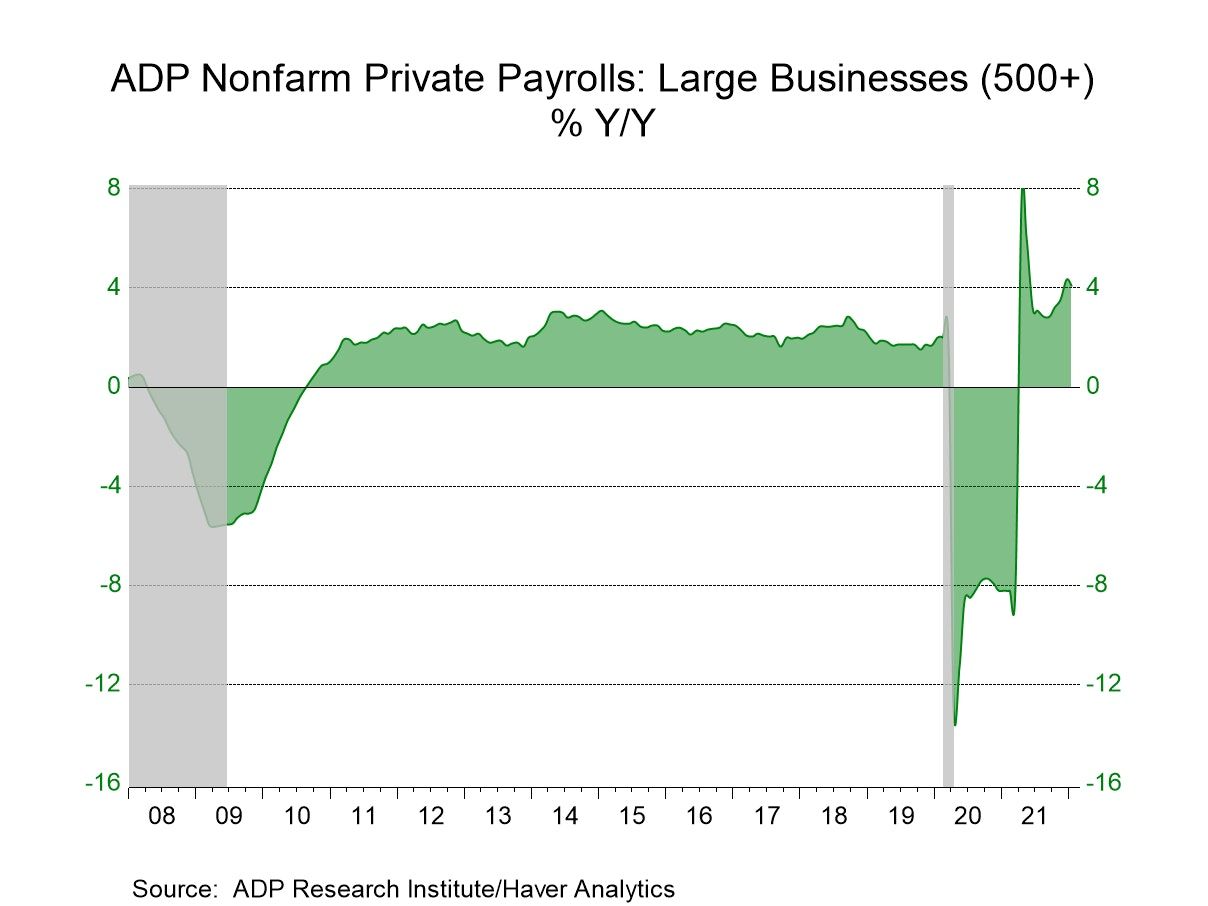U.S. ADP Nonfarm Private Payrolls Unexpectedly Decline in January
by:Tom Moeller
|in:Economy in Brief
Summary
- Omicron-related job loss is widespread.
- Leisure & hospitality sector is notably hard hit.
- Construction & factory sectors suffer significantly.


The ADP National Employment Report indicated that nonfarm private sector payrolls declined 301,000 during January (+4.7% y/y) following a 776,000 December increase, revised from 807,000. It was the first monthly decline since December 2020. A 210,000 January rise had been expected in the Action Economics Forecast Survey. The three-month average gain fell to 324,000. November payrolls increased 496,000, revised from 505,000.
ADP indicated "The labor market recovery took a step back at the start of 2022 due to the effect of the Omicron variant and its significant, though likely temporary, impact to job growth."
Small-sized payrolls were severely impacted last month, falling 144,000 (+4.5% y/y) after rising 192,000 in December. Large-sized payrolls declined 98,000 (+4.1% y/y) after increasing 378,000 in December. Medium-sized payrolls declined 59,000 last month (+6.3% y/y) following a 206,000 December gain.
Within industry sectors, private services employment led the decline last month with a 274,000 drop (+4.9% y/y) after rising 645,000 in December. Leisure & hospitality jobs weakened 154,000 in January (+16.7% y/y) which reversed most of the 239,000 December increase. The number of trade, transportation & utilities jobs fell 62,000 (+3.0% y/y) and reversed half of December's rise. The number of education & health services jobs fell 15,000 (+3.2% y/y) after rising 81,000 in December. Employment in financial services eased 9,000 (+1.5% y/y) after a 23,000 December increase. The number of information sector jobs fell in January by 8,000 (+1.7% y/y), the first decline in six months. Professional & business services jobs slipped 3,000 (+3.7% y/y) after triple-digit gains in both November and December.
Employment amongst goods-producing firms eased 27,000 (+3.8% y/y) last month following a 131,000 December rise. The number of factory sector jobs fell 21,000 last month (+2.9% y/y) after increasing 69,000 in December. Construction sector payrolls fell 10,000 in January (+4.8% y/y) after sharp increases in each of the prior four months. Employment in the natural resource & mining sector rose 4,000 last month (9.8% y/y) after rising 2,000 in December.
The Automatic Data Processing Research Institute survey covers 411,000 companies and includes about one-fifth of U.S. private payroll employment. The data are processed by Moody's Analytics Inc., then calibrated and aligned with the BLS establishment survey data. The ADP data cover private sector employment only.
The ADP National Employment Report data can be found in Haver's USECON database. Historical figures date back to 2001 for private employment and the industry breakdown, and 2005 for the business size breakout. The expectation figure is available in Haver's AS1REPNA database.


Tom Moeller
AuthorMore in Author Profile »Prior to joining Haver Analytics in 2000, Mr. Moeller worked as the Economist at Chancellor Capital Management from 1985 to 1999. There, he developed comprehensive economic forecasts and interpreted economic data for equity and fixed income portfolio managers. Also at Chancellor, Mr. Moeller worked as an equity analyst and was responsible for researching and rating companies in the economically sensitive automobile and housing industries for investment in Chancellor’s equity portfolio. Prior to joining Chancellor, Mr. Moeller was an Economist at Citibank from 1979 to 1984. He also analyzed pricing behavior in the metals industry for the Council on Wage and Price Stability in Washington, D.C. In 1999, Mr. Moeller received the award for most accurate forecast from the Forecasters' Club of New York. From 1990 to 1992 he was President of the New York Association for Business Economists. Mr. Moeller earned an M.B.A. in Finance from Fordham University, where he graduated in 1987. He holds a Bachelor of Arts in Economics from George Washington University.






